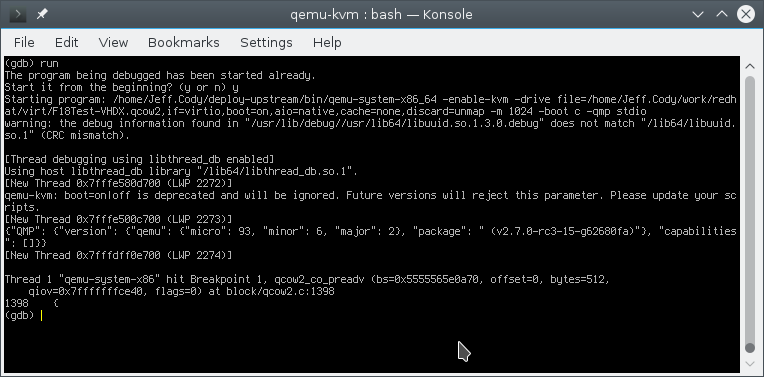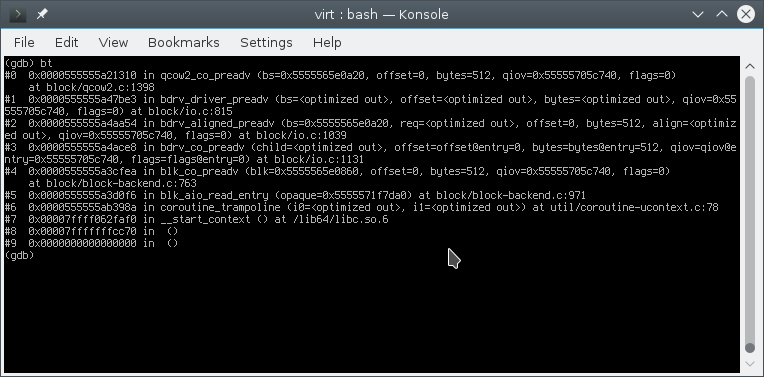

QEMU Coroutines, Exposed
Jeff Cody | jcody@redhat.comToronto, ON
August 26, 2016
Presentation available at: http://qemu.rocks/jtc-kvm2016
Agenda
-
100,000 meters
- What are Coroutines?
-
10,000 meters
- QEMU Coroutine API
-
100 meters
- Under The Covers: ucontext
- The problems with Coroutines
The 100,000 Meter View
What are Coroutines?
A way for QEMU to do
cooperative,
concurrent multitasking
Coroutines vs. Threads
- Threads
-
OS Managed
- Kernel has a scheduler
- Preemptive
- Requires more sophisticated locking
-
OS Managed
Coroutines vs. Threads
- Coroutines
-
Userspace Managed
- Nobody schedules coroutines
- Essentially just a bunch of non-local gotos
- Cooperative
- Lower transactional overhead
-
Userspace Managed
What does QEMU use?
QEMU is a hybrid architecture.
Threads are used (worker threads, vcpu threads, etc.),
in addition to coroutines (mainly in block layer)
Why does QEMU use coroutines?
QEMU uses an event loop; In the past, for long running tasks, we had to rely on callback functions
- Callbacks cumbersome, and difficult to follow
- Coroutines offer linear function flow
Where does QEMU use coroutines?
Block layer, of course!
All block I/O functions are coroutines...
... as well as some QMP commands (e.g. Block Jobs)
The 10,000 Meter View
The Coroutine API
States of a Coroutine
The Coroutine Structure
Using Coroutines, Part 1
Core API Functions:CoQueue
- Simple a queue of coroutines to be run
-
Queue entries can be scheduled to "wake up"
- Awoken entries run after yield/terminate
Using Coroutines, Part 2
CoQueue API Functions:Using Coroutines, Part 3
CoMutex API Functions
(Wait, I thought we were cooperative?!)
-
Still need to protect some sections
- E.g., image format driver writing into an image
-
qemu_co_mutex_lock()
- Try to acquire lock
- If fails: go on end of queue, and yield
-
qemu_co_mutex_unlock()
- release lock
- wakeup next co on queue
Using Coroutines, Part 4
Lock API Functions-
qemu_co_rwlock_rdlock()
- Waits for no writers
- While waiting, go on end of queue
-
qemu_co_rwlock_wrlock()
- Waits for no writers or readers
- While waiting, go on end of queue
-
qemu_co_rwlock_unlock()
- wakeup all readers, or one writer
The 100 Meter View
Underneath it all
Coroutines in QEMU
Multiple implementations:
- ucontext
- Default, most "mileage"
- Not on all platforms
- sigaltstack
- Newer, as of 2013 (Alex Barcelo)
- Available on most (all?) POSIX platforms
- Paper: "Portable Multithreading: The Signal Stack Trick For User-Space Thread Creation", Engelschall
Coroutines in QEMU
Less common implementations:- win32
- Uses Windows Fibers
- Windows-only
- gthreads
- Slow
- Not really functional
- Debug only (anyone using it?)
Coroutines Creation - ucontext
Or, fun with trampolines
-
getcontext / makecontext initializes stack
- coroutine_trampoline
- current environment saved as uc_link
-
jump on the trampline
- swapcontext() does the jump
- jmp_buf saved before coroutine fn call
- jump back to the caller
- next siglongjmp to saved jmp_buf will start fn
Coroutines Creation - ucontext
Coroutine *qemu_coroutine_new(void)
{
/* [...] */
arg.p = co;
makecontext(&uc, (void (*)(void))coroutine_trampoline,
2, arg.i[0], arg.i[1]);
/* swapcontext() in, siglongjmp() back out */
if (!sigsetjmp(old_env, 0)) {
swapcontext(&old_uc, &uc);
}
return &co->base;
}Problems with Coroutines?

-
Makes debugging painful at times
- Did I mention trampolines?
- Check out scripts/qemu-gdb.py
- "qemu coroutine coroutine ptr"

-
Portability / Platform availability
- Many methods have limited availability
- Different implementations for different platforms
-
Coroutine implementation is complex
- Does make usage easier and less error-prone
-
Can rely on compiler / glibc specific behavior
- Maybe this is fine
/*
* we want to use bottom half because we want to make sure the below
* sequence of events.
*
* 1. Yield the coroutine in the QEMU thread.
* 2. Submit the coroutine to a worker thread.
* 3. Enter the coroutine in the worker thread.
* we cannot swap step 1 and 2, because that would imply worker thread
* can enter coroutine while step1 is still running
*/
#define v9fs_co_run_in_worker(code_block) \
do { \
QEMUBH *co_bh; \
co_bh = qemu_bh_new(co_run_in_worker_bh, \
qemu_coroutine_self()); \
qemu_bh_schedule(co_bh); \
/* \
* yield in qemu thread and re-enter back \
* in worker thread \
*/ \
qemu_coroutine_yield(); \
qemu_bh_delete(co_bh); \
code_block; \
/* re-enter back to qemu thread */ \
qemu_coroutine_yield(); \
} while (0)Questions?

THE END
Jeff Cody | Red Hat, Inc.
Presentation available at: http://qemu.rocks/jtc-kvm2016
Intro video modified from fccysf's "Waterfall I: Niagara Falls"
Video licensed under CC BY 3.0
End slide photo by Farhan Amoor
Photo licensed under CC BY 2.0